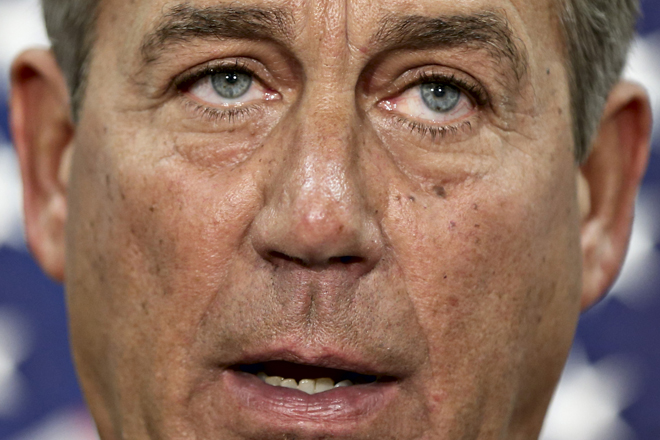Countering President Obama’s plan to avert the fiscal cliff released last week, House Republicans unveiled their own plan this afternoon that is presented as a major gesture of compromise as it finally puts tax revenues on paper and with House Republicans’ endorsement.
The big question, of course, on the fiscal cliff negotiations is what happens to tax rates for the wealthiest Americans — Democrats want them to go up, Republicans want them to stay the same. Realizing that they have to offer some kind of revenue increases, Republicans have been searching for a way to do that that doesn’t actually raise tax rates and thus violate Grover Norquist’s pledge. Boehner did that today in his proposal, which keeps revenues where they are today (by extending the Bush tax cuts on the top 2 percent of Americans), but calls for the elimination of tax deductions.
Boehner does this by leaning on the Simpson-Bowles plan, which, in case you haven’t been watching “Morning Joe” or reading David Brooks, was put forward in 2010 by a deficit-reduction commission convened by President Obama and co-chaired by former Republican Sen. Alan Simpson and former Clinton Chief of Staff Erskine Bowles.
Setting a target of $800 billion in new revenue, Boehner writes in his letter to Obama, “Notably, the new revenue in the Bowles plan would not be achieved through higher tax rates, which we continue to oppose and will not agree to in order to protect small businesses and our economy.”
Boehner has one key thing very wrong, though, as others have already noted. While the entire purpose of Boehner’s tax plan is to preserve the tax breaks for the top 2 percent, the Simpson-Bowles plan begins by allowing those rates to go up by assuming the expiration of all the Bush tax cuts. It then eliminates deductions and uses the money saved to reduce all tax rates a bit. Boehner’s plan does the opposite: It assumes the extension of the Bush tax cuts and then tries to find ways to pay for them by eliminating deductions.
The problem with this approach is that it’s basically impossible to raise any significant amounts of money without hitting the middle or lower class. Capping deductions gets you closest to that goal, as the wealthy are the most likely to take advantage of deductions, but it still doesn’t quite add up.
A $50,000 deduction cap would yield about $760 billion, just shy of what Boehner is aiming for. That cap would mostly impact the rich, according to the Tax Policy Center, but not entirely. At least 4 percent percent of the increased tax burden would fall on the lower 80 percent of Americans.
That might not seem like much, but think about that this means. Essentially, Republicans are proposing a way to preserve tax cuts for the wealthy by likely increasing taxes on the middle class, even if just a little.

